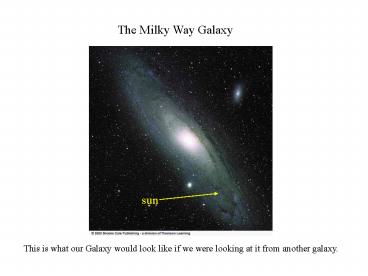The Milky Way Galaxy - PowerPoint PPT Presentation
1 / 14
Title:
The Milky Way Galaxy
Description:
When William Herschel (late 1700s) tried to measure the shape and size of the ... Herschel didn't know about different kinds of stars, he thought they were all ... – PowerPoint PPT presentation
Number of Views:86
Avg rating:3.0/5.0
Title: The Milky Way Galaxy
1
The Milky Way Galaxy
sun
This is what our Galaxy would look like if we
were looking at it from another galaxy.
2
Examples of three Milky-Way like Galaxies
- Roughly 100,000 light years across
- Roughly 100-400 billion stars
- Roughly 250 million years to rotate
3
Edge-on you can see the dust lane
Stellar disk
dust lane
The dust lane is thin, patchy disk that is
thinner than the stellar disk. This thin
gas/dust disk is the fuel for the next generation
of stars. The reason it is in such thin disk is
because of the friction between gas
clouds. This friction is due to the collisions
between gas clouds, whereas stars do not collide
4
Anatomy of Our Galaxy
- Galactic Disk
- Galactic Bulge
- Galactic Halo
- Corona
- Disk
- young and old stars
- open star clusters
- gas dust clouds (ISM)
- Bulge
- old stars
- Halo
- old stars
- globular clusters
- Corona
- very hot, ionized low density gas
100,000 lyrs
open cluster globular cluster
5
A more detailed view of our galaxy.
Note the colors the globular clusters and bulge
are reddish (cool low mass stars that are old)
whereas the disk stars are both blue (hot high
mass that are young) and reddish.
6
HOW DID WE LEARN ALL THIS FROM OUR VANTANGE
POINT?
When William Herschel (late 1700s) tried to
measure the shape and size of the Galaxy and the
suns position. He measured the direction and
distances to visible stars. He came up with
this
Herschel didnt know about different kinds of
stars, he thought they were all the same (like
the sun) and therefore all the same luminosity.
Using this assumption, he could just simply
compute the distance from the brightness.
- Two errors
- assumed all stars identical so that brightness
gave distance - did not know about dark clouds and interstellar
extinction
Brightness Luminosity/(distance)2
This was before we knew how to measure stellar
parallax.
7
Interstellar Extinction
The stellar disk appears as a bright band across
the sky from our vantage point. The reason
Hershel incorrectly deduced that the sun is in
the center is due to the presence of dark nebulae
and dust in the Galaxy. Interstellar
extinction blocks out all the star far away from
the sun.
8
Need a tool to measure distances to stars
throughout the Milky Way Need to be able to
measure distances greater than what stellar
parallax can do (about 100 pc 325 light yrs
maximum). The Milky Way is 100,000 light years
across! Turns out there is a method
VARIABLE STARS! (Hershel didnt know about this
either)
9
Cepheid Variable Stars Distance Indicator
beyond Parallax
- The brightness of these stars varies in a very
periodic way. - The period is directly proportional to the stars
luminosity! - So
- Measure the period and get luminosity
- Measure the average brightness
- Once you have average brightness and luminosity,
- you solve for distance from
- Brightness Luminosity/(distance)2
10
Cepheid Variable Stars
These stars are aging stars. They lie in a
region of the HR diagram called the Instability
Strip. A star becomes a Cepheid variable star
(unstable to oscillations) several times before
it dies. These stars are more massive than the
sun.
11
How it Works
Luminosity-Period Relation
Once you measure the period of variability you
can then just read off the luminosity.
Example. A star with a 20 day period has a
luminosity 10,000 times that of the sun.
12
Harlow Shapleys Realization (1920s)
Globular clusters seen in all directions, but
most of them are on one side of the sky!
Hershels incorrect model
globular cluster
(has lots of Cepheid variable stars in it!)
Shapleys model
Globular clusters must orbit around the center of
mass of the galaxy! Thus, assuming the
clusters are distributed uniformly around the
galaxy, he measured the 3D distribution of
clusters (using Cepheid variables) and then
assumed that the center of that distribution was
where the center of the galaxy was. He got
both the direction and distance to the galaxy
center!
13
Shapleys Map of the Galaxy
Distance From Earth/Sun, kpc
Distance From Earth/Sun, kpc
14
Shapleys Map of the Galaxy































